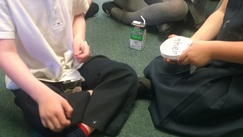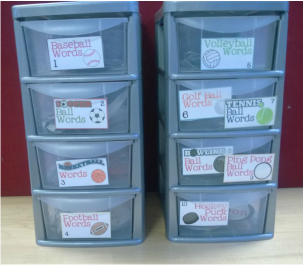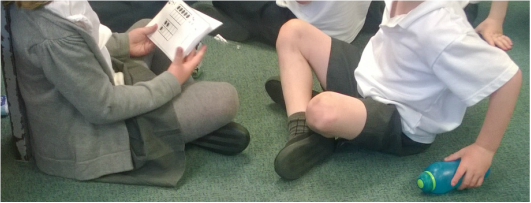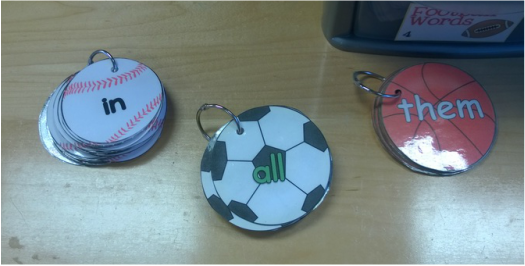 Although I always thought I'd prefer to teach older children, I've loved being in Primary 1. On Friday, I handed out all of the children's work (neatly organised into Literacy, Numeracy and IDL folders - pretty amazing for me!) for them to take home. Their most recent Daily Writing jotter will go to their new teacher, but all of their old jotters also went home with them. It was fun to watch the children look through their past work. They were all amazed and pleased at just how much they've learned this year. In no other stage is the progress so obvious and exciting. Yet one of the most important skills they've begun to develop this year is something that can't be seen in a jotter. They are starting to become self-directed, or independent, learners. It isn't perfect, and many reminders are needed, but the beginnings are there. As an early years teacher, I've encouraged independence by being consistent and continual repetition. Young children learn by imitating - so we need to make sure they have a solid foundation for 'productive imitation'. I also think they benefit greatly from some free time (we call it 'choosing time' in our class), where they are in the driver's seat and can choose what they want to do. In the picture above, one of my kiddos is quizzing another on his volleyball words. The 'teacher' just recently passed volleyball words herself, so it was lovely to see her helping her classmate (while also having the words reinforced for herself). During reading groups, we always have flashcards with key words from our book, and the children have been practicing ball words with me all year. They have seen this teacher-pupil interaction repeatedly throughout the year, so they can take ownership of it themselves. Similarly with our dot cards. The familiarity of the routine makes it easy for the children to reproduce it in their own play. In addition to this pair, another group of 4-5 children were gathered around another 'teacher' to guess how many dots. They can repeat these routines independently because they've seen and participated in them so many times. |
|
0 Comments
 This year, I used 'ball words' from Differentiated Kindergarten in my class for the first time - they were fabulous! As I type, more than two thirds of my class have learned all 220 early sight words (Dolch words) - and they've done it all independently. You can see in the pictures how I store my ball words. I'll write more about these later, but if you are curious, please click on the links for a fuller explanation. As I was listening to kiddos who are still working to master their ball words today, though, I was thinking about how we help kids develop word attack skills. My son is dyslexic, so this is an area of the curriculum that I've thought and read a lot about. In our school, we use North Lanarkshire's Active Literacy programme, which emphasises the ability to break words down into their sounds/phonemes and 'sound words out'. Which is all well and good - but what about trickier words? And things that don't seem to follow the rules we teach our kids? And how do we help those kids who need a bit more time and more support to remember the sounds that different phonemes make? For me, two keys have been: 1) repetition, repetition, repetition and 2) giving kids as much information as possible about the words they are reading. When kids are practicing their sight words and get stuck, I prompt for what the phoneme says, and if possible, I link my question to words they already know (for example, every time we get stuck with 'ay', I point to the 'day of the week' up on our white board. That's usually enough to remind them that 'ay' makes the long 'a' sound, and they can figure out the word). Some kids remember phonemes very quickly. Other kids need lots of repetition before it 'sticks'. But I also try to give them as much information about a word as I can, so that things that seem crazy 'make sense'. 'C' making an 's' sound, and 'g' saying 'j' are cases in point. When does this happen? When 'c' and 'g' are followed by 'i, e or y' (there are always exceptions, but luckily, primary 1s don't tend to pick up on them!). Now - they don't usually remember this when they are spelling the words (nise, anyone?), but when they are reading, these words don't confuse them. There is a rule that helps them make sense of it. And I've repeated that rule so often, it's stuck in the back of their memory somewhere, ready to be dragged out with a prompt or two. The more information we can give our kids to take the 'mystery' out of reading, the better. This year, we've also spent a lot of time talking about vowels and just what tricky little letters they are...if we sound out a word and it doesn't make sense, chances are, that vowel (or two) isn't playing by the rules and is making a different sound. There isn't always a rule for that one - but at least we know which letters we have to keep an eye on. Here's a picture of the first three 'ball word' sets, to give you an idea of how they are put together. I have 4-5 sets of each ball word, so there isn't an issue if several kids are working on the same list of words. |
Categories
All
About MeI have taught from P1-P5 (K-4th grade). You'll find a variety of resources and ideas appropriate for these year groups as you explore this blog. I'm glad you are here and I hope you find activities, ideas or resources that are useful in your own class. Archives
July 2020
|



 RSS Feed
RSS Feed